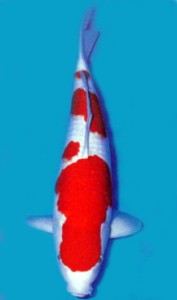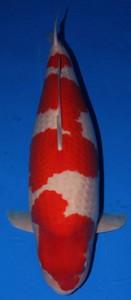Kohaku
 In Japan Kohaku are held in much higher esteem than any other variety and are consequently subjected to very searching scrutiny with outstanding specimens being particularly highly prized. In the assessment of quality of Kohaku, it is very easy to be influenced purely by the pattern. This is mistake number one, much more important in the initial assessment is the shape and skin quality of the koi.
In Japan Kohaku are held in much higher esteem than any other variety and are consequently subjected to very searching scrutiny with outstanding specimens being particularly highly prized. In the assessment of quality of Kohaku, it is very easy to be influenced purely by the pattern. This is mistake number one, much more important in the initial assessment is the shape and skin quality of the koi.
A Kohaku, or indeed any koi with a wonderful pattern, without the correct body and fine skin quality is of little value. Only when we are convinced of these first two factors should we consider patterns. In Japan many of the highly prized Kohaku used for breeding do not necessarily have outstanding patterns, but do have correct shape and excellent skin quality. Quite simply, patterns cannot be reproduced, even from the best lineage, yet correct shape and skin quality are much more likely to be reproduced. In considering body shape, look down directly from above for well rounded sides – the classic “cigar” shape. Rugby balls and straight sides should be avoided, as should pointed heads. Another important factor is that both sides should be symmetrical. Any unevenness between the two sides will be due to either an inborn deformity, which will not correct, or some potential internal problem – both of which should be avoided. The main reason for female koi being more highly prized than their slimmer male counterparts is because, particularly when large, they take on a much more rounded and pleasing shape.
Judging shape is of course very much easier with large koi but is equally important with smaller koi. Although there can be no guarantee that good shape will be maintained, starting from the correct position must surely help. Bad body shapes seldom improve with the possible exception of newly imported koi which have often been starved prior to shipping, giving the impression of a large head and slim body. With the correct care these may well improve. In these cases you can only use your experience and trust your judgment. This of course applies to all koi and not just Kohaku. The next aspect – skin quality – is probably the hardest to define. The Hi red on Kohaku should be uniform in colour so that individual scaling is not easily seen and with clear well defined edges against the white background. This is known as kiwa. Good kiwa is yet another aspect in the assessment of quality in Kohaku. The only exception being to the front edge of the Hi marking, which may be blurred. This is considered proof of good depth of Hi and is due to white scales overlaying the red.
Pattern is often the thing which attracts to a particular Kohaku but as stated previously, not necessarily the most important characteristic. Good balance is the key to good pattern. Balance being the overall effect of the red laid over the white. Neither side of the koi or the back or front should dominate.The head pattern with Hi between but not touching the eyes and forming a U shape which finishes halfway between the eyes and mouth is considered to be the classic. However, today many koi with unique head patterns breaking this “rule” are finding favour. These can make a koi look very distinctive.
Too little Hi on the head giving a bald effect, Bozu, is disliked as is Hi covering the whole head, Menkaburi, – both are unrefined.
Kuchibeni or lipstick patterns often find favour in this country, although not particularly liked in Japan. They can be useful in improving the head pattern when the main head Hi stops somewhat short. Maruten head patterns are a single rounded spot as in a Tancho.
With regard to body pattern, large markings, Omoyo, are to be preferred to small markings, Komoyo. On small koi small markings often look attractive, but as the koi grows these will produce a broken or spattered effect which lacks the imposing look we are seeking. On the other hand, large markings on the shoulder region help achieve this effect. Single unbroken Hi patterns, Ippo,n are of little value with the exception of the Inazuma or lightning patterns, which, although continuous, are varied enough to produce a pleasing overall effect. The placing of the Hi markings is important in achieving overall balance. Koi with markings predominantly at the front are unbalanced, as are those with large markings towards the rear as these give a heavy appearance. The ideal would perhaps be a koi whose largest markings are on the head and shoulders, with patterns reducing in size towards the tail.
The wrapping of Hi markings that is to say those which extend below the lateral line, are now favoured. They help to produce an imposing look on large Kohaku.
One-sided patterns, Katamoyo, are disliked as they are obviously unbalanced. Stepped patterns, Danmoyo, either 2 step (Niddan) 3 step (Sandan) or 4 step (Yondan) are the classic and traditional patterns. These days many attractive Kohaku do not fall into any of these recognised patterns, however, do not be put off by this as long as the pattern has good overall balance. Hi which runs into the fins, especially the tail, is considered a fault. The last Hi marking should step to reveal a small area of white before the tail known as Ojime. Koi with no Ojime give a heavy impression. Koi with no Hi towards the tail producing a large area of white called Bongiri are unrefined.
Windows in the Hi markings are a serious fault as the markings should be uniform. Hi staining on the dorsal is a common fault and shows a lack of qualiity. The fins should be completely white, to complement the red of the body pattern. Any black markings in the finnage are a serious defect. Small black markings on the body, called shimmies, are sometimes seen and do detract from the overall effect. In striving to produce the ideal Kohaku, a near impossible task, it should be remembered that any minor defects can be forgiven if the overall appearance in terms of quality and balance is achieved. As with the assessment of all koi, one should try to look for the good points first and any defects second.

Easier said than done, as it is perhaps always easier to criticise than praise.
Stan Collinge
